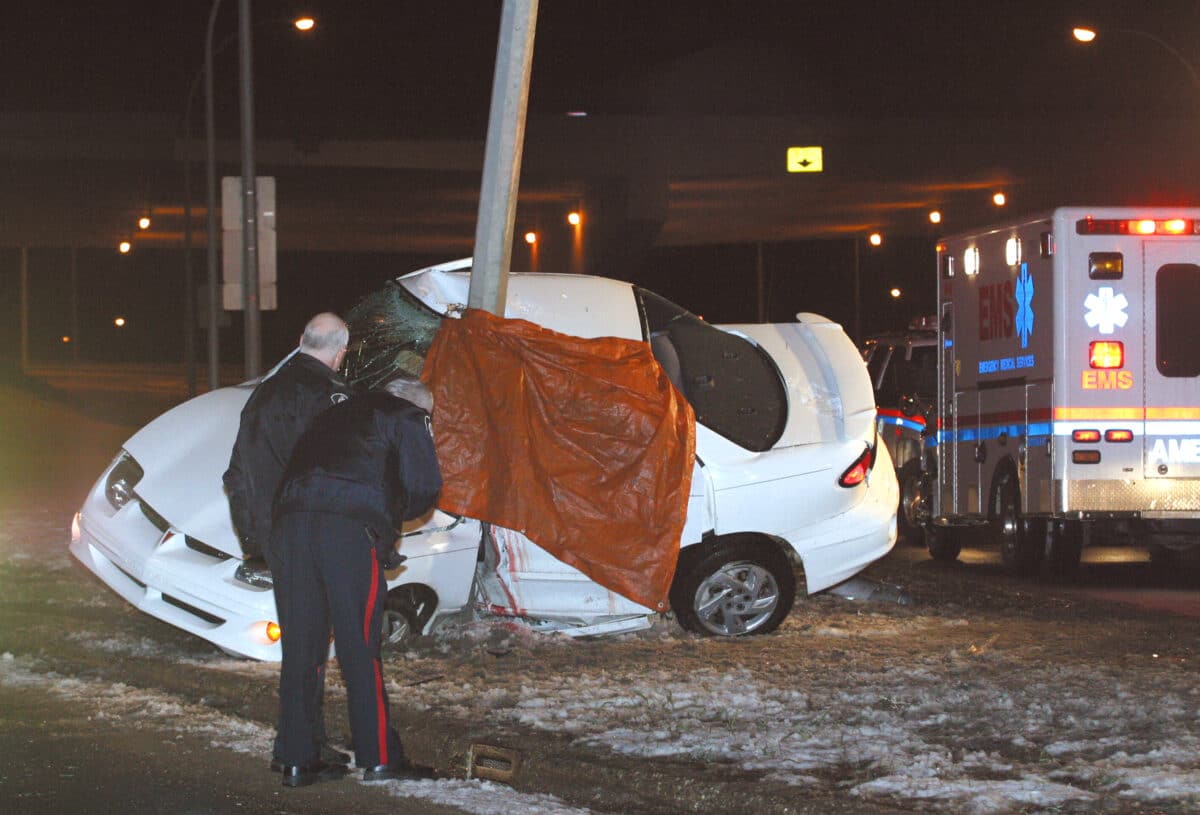
Police and paramedics tend to a deadly car accident. (Photo by Jack Dagley Photography on Shutterstock)
Teens driving older vehicles are more likely to die in accidents, study shows
In a nutshell
- Teen drivers are more likely to drive older vehicles with fewer safety features, with 27.6% operating cars over 15 years old compared to 22.8% of middle-aged drivers.
- Driving older vehicles significantly increases death risk in crashes – vehicles 6-15 years old have 19% higher risk, while those over 15 years old have 31% higher risk compared to newer models.
- Each additional safety technology (like adaptive cruise control or lane assist) reduces driver death risk by 6% in fatal crashes.
COLUMBUS, Ohio — That aging family sedan your teenager is driving? It might be a death trap, an eye-opening study concludes.
Research from Nationwide Children’s Hospital reveals that teens are more likely to be driving outdated vehicles with missing safety features when deadly car accidents happen—and it’s boosting their odds of dying when wrecks occur.
Scientists analyzed five years of fatal crash statistics and found teenagers were more often behind the wheel of cars older than 15 years in deadly wrecks. Every extra year of vehicle age increased death likelihood, while each missing safety technology bumped fatality risk by 6%.
The Hand-Me-Down Danger
The findings, published in JAMA Network Open, challenge the common practice of handing down aging vehicles to new drivers, especially as traffic collisions remain the number one killer of American teenagers. Between 2012 and 2021, teen driver deaths jumped 13%, with over 2,100 teenagers dying on the roads in 2021 alone.
Many well-meaning parents pass along their aging cars to newly licensed teens without realizing they’re increasing risk. The study examined records from 81,145 drivers caught in fatal crashes between 2016 and 2021.
The research team, headed by Fangda Zhang from Nationwide Children’s Hospital, compared vehicles driven by teenagers (15-18 years old) versus middle-aged drivers (31-55 years old) in deadly crashes.

Older Cars, Higher Risks
Among teen drivers studied, nearly 28% were driving cars older than 15 years when their fatal accidents happened—significantly more than the 23% rate for middle-aged drivers. Teens also had fewer vehicles with modern safety systems that prevent or reduce crash severity.
The numbers tell a troubling story: driving 6-15 year old vehicles brought a 19% higher death risk compared to newer models (under 5 years old), while cars exceeding 15 years of age hiked death risk by 31%.
“Older vehicles are more likely to malfunction due to degraded components like brakes and tires, less-robust design standards, and increased mechanical issues, which elevate the risk of crashes and crash fatalities,” the researchers explained in their paper.
Safety technology made a measurable difference. Every added driver assistance feature—adaptive cruise control, forward collision warnings, lane assistance systems, or advanced lighting—cut death risk by 6% when crashes happened.
What Parents Can Do
The findings offer essential guidance for anyone with teenage drivers. Instead of giving teens the family’s oldest car, parents should focus on safety features when choosing their child’s first vehicle.
“These findings suggest that older vehicles and those with fewer driver assistance technologies are associated with increased risk of driver death in fatal crashes; thus, teens should drive the safest vehicles available, not older family cars,” the researchers wrote.
Modern safety systems provide real-time help that either prevents crashes entirely or reduces how bad they are. Automatic emergency braking can spot and react to dangers faster than humans. Blind spot systems warn about cars hiding in your mirrors’ blind zones, while stability control keeps vehicles from spinning out during emergency maneuvers.

For families without money for newer cars, better maintenance of older vehicles might improve safety. Researchers also suggested nationwide safety checks for vehicles over 15 years old, since regular inspections help catch dangerous defects that cause crashes.
Pediatricians and family doctors can also help by educating families about these risks. During teens’ checkups as they approach driving age, healthcare providers should discuss vehicle safety alongside other risk factors.
The bottom line is simple: teen drivers need the newest, safest vehicle a family can afford—not the outdated hand-me-down that nobody else wants to drive.
Paper Summary
Methodology
This retrospective cohort study used data from the Fatality Analysis Reporting System (FARS), examining fatal crashes in the United States from 2016 to 2021. Researchers analyzed information from 81,145 drivers, including 9,809 teens (15-18 years old) and 71,336 middle-aged drivers (31-55 years old). They categorized vehicles by age (≤5 years, 6-15 years, or >15 years) and counted the number of driver assistance technologies installed (ranging from 0 to 4), including adaptive cruise control, forward collision prevention, lane and side assist, and lighting technologies. The primary outcome measured was whether the driver died in the crash, and researchers used multivariable logistic regressions to examine associations between vehicle characteristics and driver death, adjusting for factors like driver sex, restraint use, and crash year.
Results
The study found that teen drivers were significantly more likely to operate vehicles older than 15 years compared to middle-aged drivers (27.6% vs. 22.8%). Teens were also less likely to drive vehicles equipped with lane and side assist technologies. Vehicle age was strongly associated with driver death risk, with vehicles 6-15 years old having 19% higher risk of driver death (adjusted risk ratio 1.19) and vehicles older than 15 years having 31% higher risk (adjusted risk ratio 1.31) compared to vehicles 5 years or newer. Each additional driver assistance technology was associated with a 6% reduction in death risk (adjusted risk ratio 0.94). These associations were consistent across both age groups of drivers.
Limitations
The researchers acknowledged several limitations. First, they relied solely on fatal crash data, which meant they could not determine the overall risk of fatality, only associations within fatal crashes. Second, relatively few vehicles in the dataset had comprehensive information about safety technologies, limiting deeper analysis of specific features. Third, the safety technology data might be incomplete, and some technologies might have been installed but not activated during crashes. Finally, the study didn’t examine other potentially important factors like driver behaviors, crash types, vehicle models, and road conditions.
Funding/Disclosures
Research for this study was partially supported by the Eunice Kennedy Shriver National Institute of Child Health & Human Development of the National Institutes of Health (grants R01HD098176 and R01HD100420) and Centers for Disease Control and Prevention (grant R49CE003074). The authors reported no conflicts of interest.
Publication Information
The study, titled “Vehicle Age and Driver Assistance Technologies in Fatal Crashes Involving Teen and Middle-Aged Drivers,” was published in JAMA Network Open on May 7, 2025. The authors included Fangda Zhang, Christopher R. M. Rundus, Enas Alshaikh, Corinne Peek-Asa, and Jingzhen Yang from the Center for Injury Research and Policy at Nationwide Children’s Hospital, the Office of Research Affairs at the University of California at San Diego, and the Department of Pediatrics at The Ohio State University.







